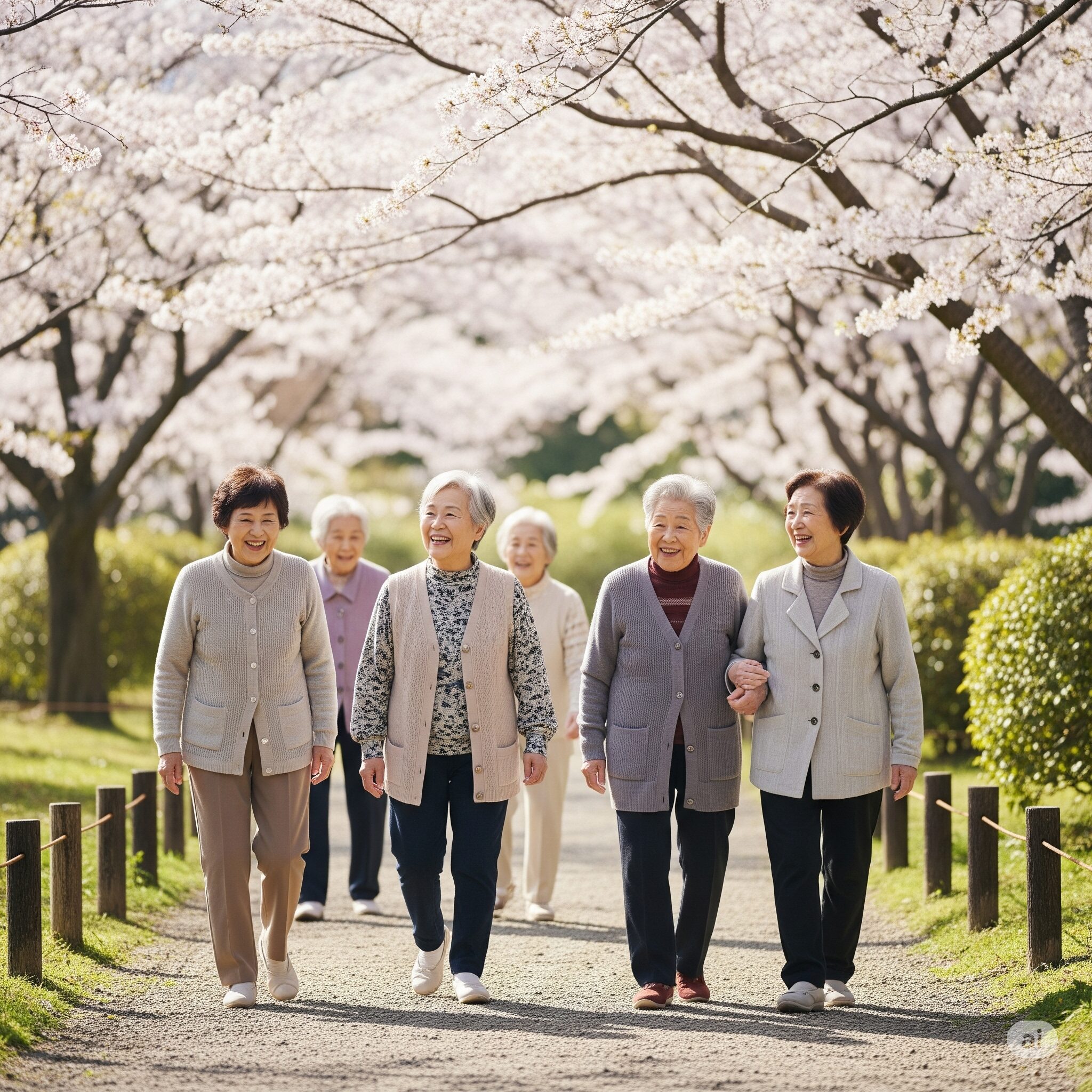✨ Introduction: A Society Designed for Well-Being
Japan is globally recognized for its exceptional longevity. With one of the highest life expectancies in the world—currently around 88 years for women and 82 for men—Japan is often seen as a model of healthy living. But this isn’t just a modern achievement. The roots of Japan’s health-conscious culture stretch back centuries, embedded in its social systems, spiritual practices, and community values.
In Japan, the foundations of society—from village rituals to national governance—have long been oriented toward three core goals:
- 🧘♂️ Health
- 👵 Longevity
- 🌸 Prosperity
This article explores how these values have shaped Japan’s past and continue to influence its present.
- 🏯 Ancient Foundations: A Culture That Honors Life
- 🌾 Shrines and Rice: The Original Public Health System
- 🧓 Age Before Status: A Culture That Celebrates the Elderly
- 🛡️ Governance for the People’s Well-Being
- 🌸 Cultural Indicators of a Health-Oriented Society
- 🌟 Conclusion: A Nation Rooted in Respect for Life
🏯 Ancient Foundations: A Culture That Honors Life
📜 Egalitarianism in Ancient Japan
As early as the 3rd century, Chinese records such as the Gishi Wajinden described the Japanese as egalitarian and community-minded. In village meetings, people sat together without regard to gender, wealth, or social status. This principle of equality was not just political—it was spiritual.
By the 8th century, legal commentaries like the Ryo no Shūge described how villagers gathered at local shrines to pray, share meals, and receive guidance from the central government. These gatherings were followed by naorai—communal feasts where seating was arranged not by rank, but by age. The eldest sat at the head of the table, regardless of wealth or title.
This age-based respect system reveals a profound cultural truth: in Japan, longevity is not just a biological milestone—it is a moral and social virtue.
🌾 Shrines and Rice: The Original Public Health System
In ancient Japan, shrines were more than religious sites—they were the heart of the community. Villagers offered rice to the gods during harvest festivals, and shrine priests (shashu) would lend rice and seeds back to the community as needed. This created a cycle of mutual support and food security.
Here’s how it worked:
- Farmers gave half their harvest to the government and half to the local shrine.
- Both institutions stored the rice for up to three years.
- In times of disaster or poor harvest, the stored rice was redistributed to the people.
This system ensured that food was always available, even in times of crisis. It was a decentralized, community-based safety net—one that remained in place in various forms until the late 1960s.
🧓 Age Before Status: A Culture That Celebrates the Elderly
In many societies, social rank or wealth determines one’s place at the table. But in traditional Japan, it was age that mattered most. Whether rich or poor, powerful or humble, everyone deferred to the eldest person in the room.
This custom still survives in rural areas today. At community gatherings, the oldest grandmother often sits at the head of the table—not because of her title or income, but because she has lived the longest.
This cultural norm reflects a deeper truth: Japan has long valued health and longevity over hierarchy and material success. A photo of a 100-year-old grandmother surrounded by four generations of family evokes more admiration than a photo of politicians or CEOs.
🛡️ Governance for the People’s Well-Being
Japan’s historical governance systems were not built solely on power or control. They were designed to ensure the safety, stability, and health of the population. The government collected rice not to hoard wealth, but to redistribute it through public works and community support.
Even today, Japan’s national policies reflect this legacy:
- Universal healthcare ensures access to high-quality medical care.
- Public hygiene standards are among the highest in the world.
- The traditional Japanese diet—low in fat, rich in vegetables and fermented foods—is globally recognized for its health benefits.
These systems are not accidental. They are the modern expression of a centuries-old philosophy: that the role of the state is to protect and promote the well-being of its people.
🌸 Cultural Indicators of a Health-Oriented Society
- 🧓 Elders are celebrated, not sidelined.
- 🏡 Community events prioritize inclusion and intergenerational bonding.
- 🍱 Meals are seasonal, balanced, and often shared.
- 🧘♀️ Wellness is spiritual as well as physical.
- 🧼 Cleanliness is a national virtue, from public baths to spotless streets.
Even in modern Japan, these values persist. From the reverence shown to centenarians to the meticulous care in preparing a bento lunch, the culture continues to affirm that health and harmony are the highest forms of wealth.
🌟 Conclusion: A Nation Rooted in Respect for Life
Japan’s long-standing emphasis on health, longevity, and prosperity is not a coincidence—it is the result of centuries of cultural refinement. From ancient rice-sharing rituals to modern healthcare systems, Japan has consistently placed human well-being at the center of its national identity.
In a world increasingly driven by speed, competition, and consumption, Japan offers a different model: one where living well means living long, living together, and living with care.
So the next time you see a 100-year-old Japanese grandmother smiling with her great-grandchildren, remember: that smile is the product of a society that has spent centuries learning how to live well.



コメント